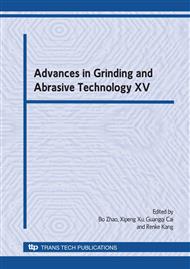p.264
p.269
p.274
p.279
p.284
p.289
p.295
p.300
p.306
Effect of Ultrasonic on Grain Density of Electroplated Diamond Tools
Abstract:
Coating quality and electroplating efficiency can be improved by application of ultrasonic agitation. The nickel coatings and electroplated diamond tools were fabricated. The effects of ultrasonic agitation on tool fabrication processes were analyzed. Cathode polarization curves and coating hardness were measured. Diamond grains on tool substrate were observed with microscope. Alumina grinding experiments were carried out and grinding ratios were calculated. Experimental results show that cathode polarization degree reduced during ultrasonic electroplating processes. Before diamond grain tack-on operation, ultrasonic agitation can make grain dense and guarantee nice contact between substrate and grains. High grain density of diamond tool can be obtained in tack-on operation after above ultrasonic agitation operation. Ultrasonic agitation is not suitable for the tack-on operation of diamond grains. During buildup processes, some buildup time is needed to obtain enough thickness of nickel coating before ultrasonic agitation is applied. The diamond tools fabricated with ultrasonic agitation present better cutting ability. During tool fabricating processes, the reasonable application of ultrasonic agitation is necessary.
Info:
Periodical:
Pages:
284-288
Citation:
Online since:
September 2009
Authors:
Keywords:
Price:
Сopyright:
© 2009 Trans Tech Publications Ltd. All Rights Reserved
Share:
Citation:


